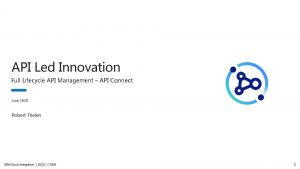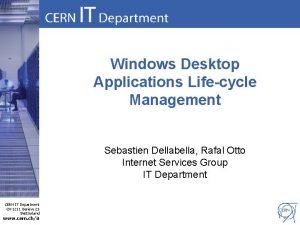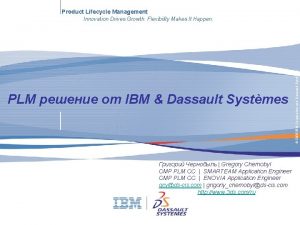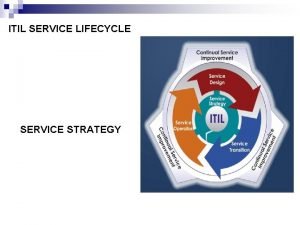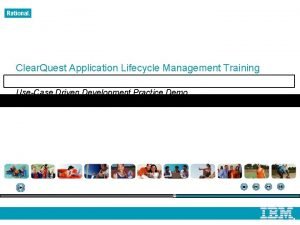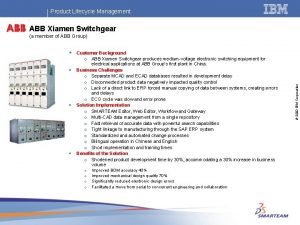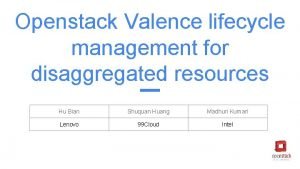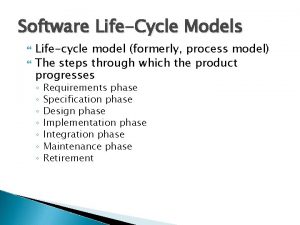Vo IP Full Lifecycle Management Russell M Elsner


















- Slides: 18

Vo. IP: Full Lifecycle Management Russell M. Elsner APM Technology Director OPNET Technologies, Inc.

Agenda • Motivation • Components of the Vo. IP life cycle – Pre-deployment – End-user experience monitoring – Continuous optimization • Benefits of an end-to-end approach • Conclusion

Motivation • The wide acceptance of Vo. IP leads to the false hope that Vo. IP is “just another application” • However, most Vo. IP deployments fail initially – New challenges managing data and voice on same network – Requires careful planning of capacity, Qo. S, etc. • Additional challenges in maintaining adequate voice service quality as additional applications are deployed over same network infrastructure • Performance problems will occur sooner or later – Can be network, server or application related – Need for problem detection and root cause analysis solutions

Challenges • Before deployment – Is my network ready for Vo. IP? – How do I configure my network to accommodate Vo. IP? • After deployment – – Is my Vo. IP service delivering adequate call quality? What is the root cause of a performance problem? How do I resolve the problem? How do I guarantee performance is maintained as new users and applications are added to the network?

VOIP Life Cycle 1. Pre-Deployment Planning & Assessment Traffic data Baseline data traffic • Baseline data traffic for pre-deployment planning and post-deployment evaluation Perform Vo. IP readiness assessment • Build network model with baseline data traffic • Add VOIP traffic (projected call volumes) • Predict MOS or R-Factor and impact on data traffic • Add capacity or Qo. S, if required • Predict behavior under failure scenarios 2. Ongoing Operations Monitor and troubleshoot Vo. IP traffic • Track call quality of Vo. IP traffic • Evaluate how data traffic is affected • Troubleshoot performance problems with drilldown into specific calls • Compare current network load with forecast 3. Optimization Continuously reengineer and optimize the network • Add additional capacity or Qo. S to resolve performance issues • Tune queues based on measure data and VOIP volumes • Trend VOIP and data traffic to predict future capacity bottlenecks • Test configuration changes prior to deployment in virtual network environment

VOIP Life Cycle 1. Pre-Deployment Planning & Assessment Traffic data Baseline data traffic • Baseline data traffic for pre-deployment planning and post-deployment evaluation Perform Vo. IP readiness assessment • Build network model with baseline data traffic • Add VOIP traffic (projected call volumes) • Predict MOS or R-Factor and impact on data traffic • Add capacity or Qo. S, if required • Predict behavior under failure scenarios 2. Ongoing Operations Monitor and troubleshoot Vo. IP traffic • Track call quality of Vo. IP traffic • Evaluate how data traffic is affected • Troubleshoot performance problems with drilldown into specific calls • Compare current network load with forecast 3. Optimization Continuously reengineer and optimize the network • Add additional capacity or Qo. S to resolve performance issues • Tune queues based on measure data and VOIP volumes • Trend VOIP and data traffic to predict future capacity bottlenecks • Test configuration changes prior to deployment in virtual network environment

Pre-deployment • What is in my network today? – Identify devices and configurations – Baseline applications and traffic – Overlay traffic on network topology • Impact of adding a new technology or application such as Vo. IP? – Testing in lab environment – Pilot projects and emulation on production network – Network simulation in virtual network environment

What is in my network today? Step 1: Build a topological view of the network based on device configuration data

What is in my network today? Step 2: Collect application traffic data

What is in my network today? Step 3: Overlay traffic on network topology

Pre-deployment Planning • Lab testing: needed but not able to replicate scale of full deployment • Pilot projects or emulation on production network should be handled with care not to break existing operations • Simulation in a virtual network environment is able to reproduce full scale deployment without affecting the production network

Vo. IP Planning • Assess the impact of Vo. IP on existing network and data • Predict bandwidth and performance (MOS, R-Factor) impact • Generate design recommendations w. r. t. capacity, Qo. S, etc.

VOIP Life Cycle 1. Pre-Deployment Planning & Assessment Traffic data Baseline data traffic • Baseline data traffic for pre-deployment planning and post-deployment evaluation Perform Vo. IP readiness assessment • Build network model with baseline data traffic • Add VOIP traffic (projected call volumes) • Predict MOS or R-Factor and impact on data traffic • Add capacity or Qo. S, if required • Predict behavior under failure scenarios 2. Ongoing Operations Monitor and troubleshoot Vo. IP traffic • Track call quality of Vo. IP traffic • Evaluate how data traffic is affected • Troubleshoot performance problems with drilldown into specific calls • Compare current network load with forecast 3. Optimization Continuously reengineer and optimize the network • Add additional capacity or Qo. S to resolve performance issues • Tune queues based on measure data and VOIP volumes • Trend VOIP and data traffic to predict future capacity bottlenecks • Test configuration changes prior to deployment in virtual network environment

Ongoing Operations • Monitor and troubleshoot poor call quality from the end-user’s perspective – Monitor the interaction of both data and Vo. IP running on the same network – Monitor real-calls with passive speech quality analysis • Receive automatic alerts based on low MOS scores • Easily identify the root-cause of poor call quality before it affects the business

VOIP Life Cycle 1. Pre-Deployment Planning & Assessment Traffic data Baseline data traffic • Baseline data traffic for pre-deployment planning and post-deployment evaluation Perform Vo. IP readiness assessment • Build network model with baseline data traffic • Add VOIP traffic (projected call volumes) • Predict MOS or R-Factor and impact on data traffic • Add capacity or Qo. S, if required • Predict behavior under failure scenarios 2. Ongoing Operations Monitor and troubleshoot Vo. IP traffic • Track call quality of Vo. IP traffic • Evaluate how data traffic is affected • Troubleshoot performance problems with drilldown into specific calls • Compare current network load with forecast 3. Optimization Continuously reengineer and optimize the network • Add additional capacity or Qo. S to resolve performance issues • Tune queues based on measure data and VOIP volumes • Trend VOIP and data traffic to predict future capacity bottlenecks • Test configuration changes prior to deployment in virtual network environment

Continuous Optimization • Growth and change affect network and application performance • Need to be planned for in advance – Assess the impact of adding new Vo. IP users, perform redesign to add new branch offices, etc. – Optimize network capacity and Qo. S configurations as Vo. IP and other traffic growth in your network – Validate configuration changes prior to deployment to identify security gaps and minimize the risk of downtime

Benefits of an End-to-End Approach Address different parts of the life cycle with a common toolset: – Accelerate Vo. IP deployments by accurate predeployment planning – Optimize the end-user experience – Rapidly move from problem detection to root cause analysis and problem resolution – Minimize errors by ensuring all decision making is based on common and up-to-date network data

Conclusion • Before you roll out Vo. IP, make sure that – – You understand the current network configuration You baseline existing application traffic You have adequate network capacity You define the call quality that meets your user’s expectation • After you have rolled out Vo. IP, make sure that – – You monitor and troubleshoot call traffic and end-user experience You leverage traffic measurements for adequate planning and Qo. S You continuously reengineer the network for growth and change You validate changes before deployment • Use a full life cycle approach to guarantee network and application performance before, during, and after deployment
 Full lifecycle api management
Full lifecycle api management Russell and taylor operations management
Russell and taylor operations management Cern cmf
Cern cmf Student life cycle model
Student life cycle model Student lifecycle management system
Student lifecycle management system Supplier lifecycle management
Supplier lifecycle management Cognos support lifecycle
Cognos support lifecycle Innovation management cloud
Innovation management cloud Itil phases
Itil phases Oracle information lifecycle management
Oracle information lifecycle management Hp application lifecycle management automation
Hp application lifecycle management automation Lead lifecycle mangement
Lead lifecycle mangement Research data lifecycle management
Research data lifecycle management Application lifecycle management training
Application lifecycle management training Product lifecycle management agile
Product lifecycle management agile Container lifecycle management
Container lifecycle management Chemical life cycle management
Chemical life cycle management Abb life cycle management
Abb life cycle management Openstack lifecycle management
Openstack lifecycle management
